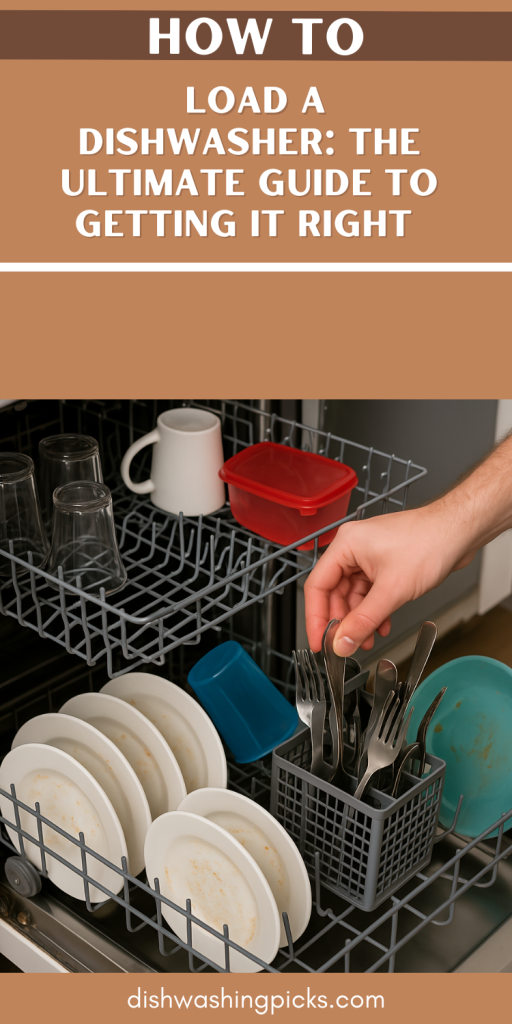Okay, let’s get real for a second. We’ve all been there – the sink piled high with dirty dishes, and that trusty dishwasher sitting in the corner, just waiting to work its magic. But here’s the kicker: there’s a trick to loading it that can make or break your whole dishwashing experience. So, how do you load a dishwasher the right way? Let’s dive in and figure it out, because let’s face it, we’ve all made some pretty… questionable choices when it comes to this!
Don’t Just Throw Stuff In
First things first – if you’ve ever just tossed dishes into the dishwasher like it’s a game of Tetris, you’re not alone. We’ve all been there. But here’s the deal: it’s not just about shoving everything in. There’s a method to this madness. You’ll want to make sure your dishes are actually getting cleaned, and not just spinning around in circles. Sounds obvious, right? But trust me, we’ve all been guilty of this “load it and forget it” approach.
So, how do you actually load it right? Well, it’s all about placement, baby. Plates go on the bottom rack, but not just any way. Face them towards the center. They need to be angled to catch the water jets – not just stacked on top of each other like you’re building a house of cards.
Imagine this: You’re putting plates on the bottom, right? Now, think of it like you’re placing them in a row, but each one needs its space to breathe. They don’t need to hug each other. Think of it like social distancing, but for your dinnerware.
The Top Rack: Glasses and Cups Have Their Place
Okay, so the top rack is a whole different ball game. Here’s a fun fact – that’s where your glasses, mugs, and smaller stuff like bowls go. But the trick is to arrange them properly so they don’t topple over during the wash. You know those cute little wine glasses you love? Put them in the designated slots (if your dishwasher has them). Don’t just toss them in willy-nilly because that’s a recipe for disaster.
And let’s talk about mugs for a sec. If you’ve ever had a mug end up with soap stuck inside it because it was placed wrong, you get it. That’s a mistake we should all avoid. Place them upside down, angled, so they can drain properly. Trust me, your morning coffee will thank you later.
Now, I know what you’re thinking – “This seems like a lot of rules for just putting some dishes in a machine!” But bear with me, I promise you’ll thank me when you see how much better your dishes come out.
The Silverware Slot Shuffle: It’s Not Just for Fun
Alright, now let’s talk about silverware – and no, it’s not as simple as just tossing forks, knives, and spoons into that little basket. I know, we all have those days when we just drop everything in there and pray for the best, but here’s the thing: there’s actually a pretty decent strategy to this.
So, here’s the deal: mix it up. Forks, spoons, and knives don’t need to be stacked neatly on top of each other. If you just toss them all in, you’re going to end up with clumps of dirty silverware that didn’t get cleaned properly. Instead, place them in the basket so they’re alternating – forks next to spoons, knives next to forks – this way, the water can get between each piece and give them a good scrub. Oh, and always place knives with the blades facing down. Safety first, right?
Also, make sure that the smaller items (like teaspoons) aren’t buried under larger utensils. Give them some space. You know, like letting people have their personal bubble at a party. You wouldn’t want to smush your silverware together.
Wait, but what about those plastic items you throw in there, like Tupperware or plastic cups? Good question, I’m glad you asked! Here’s a quick tip: place plastic items on the top rack only. The bottom rack can get super hot, and guess what? Your plastic stuff won’t be too happy about that. So, keep it cool by putting those lighter items on the top.
The Dishwasher’s Hidden Trick: Use the Right Detergent
Alright, this one isn’t exactly about loading, but it’s crucial, so stay with me. You could load your dishwasher like a pro, but if you’re using the wrong detergent, it could all be for nothing. Yep, I said it. The detergent makes a huge difference.
Some dishwashers work better with certain detergents, so make sure you’re using the right one. You ever opened the dishwasher after a cycle and noticed that some things still look kinda… dirty? Maybe there’s residue or spots on your glasses? That could be because of the detergent. And don’t even get me started on pods – sometimes they get stuck, or worse, they don’t dissolve properly. So, check your machine’s manual (yes, I know it’s boring) and find out what kind of detergent it likes best.
But hey, don’t let this stress you out. You’ve got this! A little experimenting with detergent types and you’ll soon know what works best for your machine. Trust me, it’s worth the effort.
Final Hack: Don’t Overload – Seriously
Here’s the part where I get all serious on you: don’t overload your dishwasher. I know, I know – it seems tempting to fit in just one more dish or squeeze in a few extra bowls. But here’s the thing: an overcrowded dishwasher won’t clean well. The water jets need space to do their thing, and if everything is jammed in there like it’s a game of Jenga, well… you’re just asking for trouble.
Picture this: You’ve got a half-loaded dishwasher, and then you add a couple more items because you really don’t want to hand-wash them. But now, your plates are stacked on top of each other, your cups are all leaning against each other, and there’s no room for the water to spray. What do you think happens next? Exactly – dirty dishes, my friend. It’s like packing your suitcase and hoping everything stays wrinkle-free – it just doesn’t work that way.
Instead, leave a little room between everything, so the water jets can reach every surface. It’s like giving your dishes their personal space. Everyone’s happier that way.
Loading a Dishwasher Is an Art (And You’re the Artist)
So, there you have it – the basics of loading a dishwasher like a pro. It’s all about the placement, spacing, and giving your dishes the love and care they deserve (without going overboard). Once you get into the groove, it’ll feel like second nature. You won’t be scrambling to figure out where everything goes, and your dishwasher will be working at its best, cleaning your dishes perfectly every time.
Next time you load up, think about these tips – angle your plates, mix up the silverware, give your plastics some space, and, whatever you do, don’t overload it.
And hey, if you’ve got your own dishwasher hacks, hit me up! What works for you? Share your best tips, and let’s keep this dishwasher wisdom flowing. Trust me, it’s a conversation worth having!

